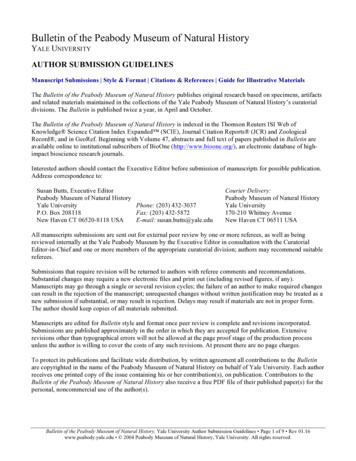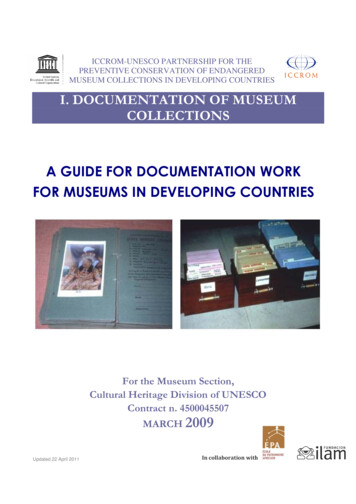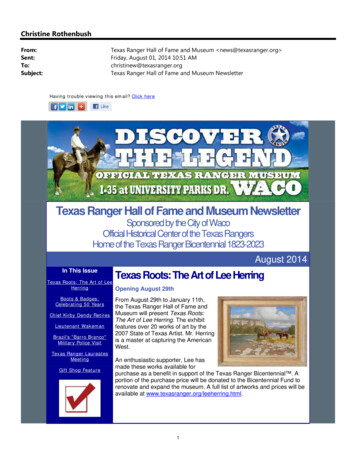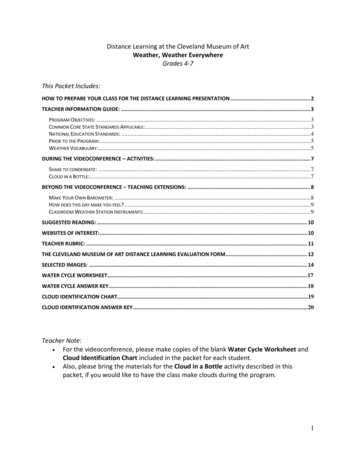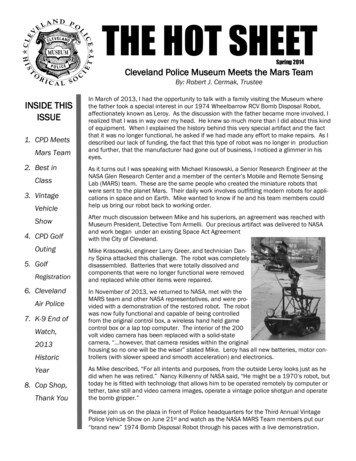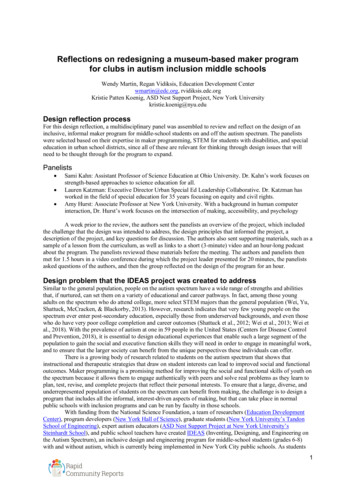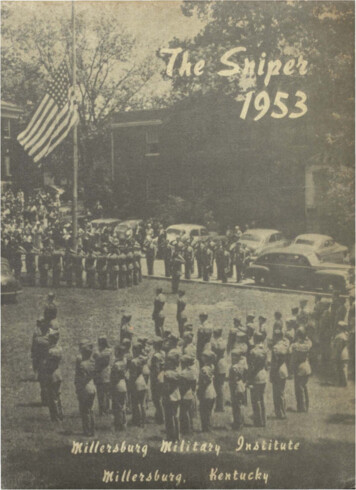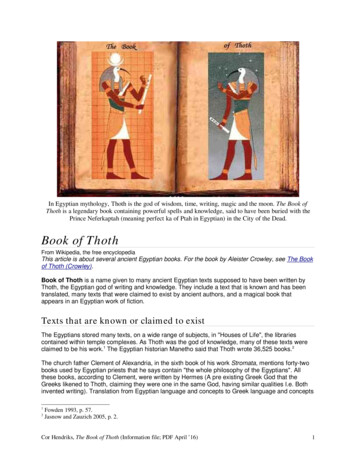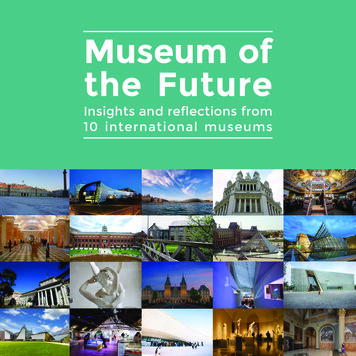
Transcription
Museum ofthe FutureInsights and reflections from10 international museumsRijksmuseum
Mu.SA: Museum Sector AllianceMu.SA ConsortiumThe Mu.SA Consortium is a rich mix of higher education institutions, independent andnational research centers, cultural and social associations and organisations, and a majorEuropean network.Result Number: usa.euTitle: Project Management HandbookProject LeaderHellenic Open University (HOU) GreeceVersion: DRAFTProject PartnersSymbola – Foundation for Italian Qualities ItalyMelting Pro Learning (MeP) ItalyICOM Portugal PortugalLink Campus University (LCU) ItalyNational Organisation for the Certification of Qualifications and Vocational Guidance(EOPPEP) GreeceUniversity of Porto (U.PORTO) PortugalInstitute of Vocational Training AKMI (AKMI) GreeceIstituto per I Beni Artistici Culturali e Naturali della Regione Emilia Romagna (IBACN) ItalyICOM Greece GreeceCulture Action Europe (CAE) BelgiumMapa das Ideias (MAPAS), PortugalEditorsDomenico Sturabotti Director of Symbola FoundationTableof ContentsRomina Surace- Research Office Symbola FoundationTeam1.The Mu.SA project .7Sabina Rosso Symbola Foundation1.1 KeyInformation.7RominaSuraceSymbola FoundationAntonia Silvaggi Melting Pro Learning1.2 The Mu.SA Consortium .7Graphic Design1.3 Aims and Objectives .8Viviana Forcella Symbola Foundation1.4 Mu.SA Results .9Photo credits Images used in this document have either been taken by project partners or are1.4.1of short-term results .9imagesfromOverviewCreative Commons.1.4.2Summary of Project Results. 12ISBN97888992651821.4.3Summaryof Key Project Deliverables . 18Mu.SAProject(2016-2019)The Mu.SA “Museum Skills Alliance” project aims to address the increasing disconnection2.Management & Communication Strategy . 24between formal education and training and the world of work because of the emergence of2.1jobWorkingrolesand.24newroles dueMethodology,to the quickeningpaceof responsibilitiesthe adoption of ICTin the museumsector. To as2.2 Steering Committee . 27Reproduction and/or total or partial distribution of the information contained in this volume is permitted providedthat the source is mentioned: “Symbola Foundation - Museum of the Future, Mu.SA Project”.The European Commission support for the production of this publication does notconstitute an endorsement of the contents which reflects the views only of theauthors, and the Commission cannot be held responsible for any use which may bemade of the information contained therein.3ERASMUS / SECTOR SKILLS ALLIANCESwww.project-musa.eu-Insights and reflections from10 international museums575907-EEP-1-2016-1-EL-EPPKA2-SSA2Museum ofthe Futuresist cultural professionals to deepen their knowledge and skills for the digital transformation of the museum sector, the Mu.SA project is designing and testing a unique trainingmethod.Running over the course of 36-months (01/11/2016-31/10/2019) the Mu.SA project is funded by the European Commission’s Erasmus Programme.
Contentsp. 6Introductionp. 26HermitageKiasmaMuseum ofContemporary ArtMAATMuseum of Art,Architecture andTechnology040506MUSEMuseo delleScienze di Trentop. 34p. 62p. 54Musée du LouvreNational MuseumWalesAmgueddfa Cymru07p. 74Museo Nacionaldel Prado0809POLINMuseum of theHistory of PolishJewsp. 92Rijksmuseump.8210p. 104Victoriaand Albert Museump. 114References5p. 18p. 4403-02401
ntroductionIntroduction3Data refer to trade revenues, IFPI Report 2013.and participation.Museums have begun a long processthrough which they are adjusting themselvesto these new dynamics, in favor of morehorizontal systems and new communicationlanguages. At one time, these culturalinstitutions used to display objects. Today,they connect the multiplicity of ideas andthe knowledge that different peoples havedeveloped based on these same objects.The task that museums are now expectedto carry out, on-site and on-line, is sharing,inside and outside, collections and variouscontents generated by artifacts.1. Where is the museum of the futureheading?Digital culture modernizes museums’vocabulary; sharing is definitively one of thekeywords of the future. Sharing collectionsand spaces, creating connections with newaudiences; even those apparently distant.Sharing means opportunity for growth andit represents a tool of indirect marketing,useful to broaden the audience.Since the centrality of the public is moreand more important, the kind of experiencethat museums can propose to its visitors,on-site and on-line, becomes the core oftheir cultural offering. Extensive knowledgeof their public is the essential element to7but because technology has given us newtools: digital compact cameras and mobilephones.What will happen to museums when digitaltechnology shows its full potential? Whatfeatures will the museum of the future have?How will it seize the opportunities offeredby digital innovation? What competenciesdoes this industry need to keep museumsrelevant from the twentieth century tothe present? To understand what role thedigital driver is playing in the modernizationof the industry, we asked these questionsto ten internationally renowned Europeanmuseums, where varying types and sizes ofcollections are conserved.The liquefaction of hierarchies and socialfunctions leads museums to open up; theyare no longer closed systems as they usedto be in the twentieth-century, but partsof wide systems of scientific, cultural, andterritorial relationships. Users are no longerjust consumers of cultural products, but theyare becoming active subjects of contentproduction and conveyance. The museumof the future either will be a collective workor will not exist. It will be developed and cocreated with the larger communities, whichwill support it and share decisions on it. Inthis transition, digital innovation providesthe infrastructure that multiplies theopportunities for exchange, 01/digital-in-2017in-italia-e-nel-mondo2Cultural Statistics 2016, Eurostat.1then came mp3s, downloading, streaming,new devices (PCs, iPods, mobile phones) andselling platforms (iTunes, Google Play, Amazon,Spotify). The role of the major companies, whichonce led market dynamics and set the balancein the music industry, has been downsizedand re-defined: in the years between 2001 and2013 the revenue of the global industry wentfrom 27.6 to 15 billion USD3. Old devices andold markets (like vinyl, for example) have notdisappeared, but they now live in a completelyrenovated ecosystem.Music is just one example of how digitaltechnology can change the game. Texts,which once would be read in books boughtin bookstores or in the newspapers boughtat the newsstands, are now read on theInternet or downloaded on Kindle e-readers,tablets or mobile phones. Bookshops have notdisappeared, but giants like Borders, the secondlargest chain in the USA, have closed down.Platforms like Booking have revolutionized theway trips and holidays are organized, to thebenefit of consumers and to the detriment oftraditional travel agencies. Kodak, one of thefew companies that, together with GeneralElectric, was on top of the rankings for financialcapitalization for most of the last century,has disappeared within only a few years, notbecause people do not take pictures any more,6The internet is today what electricity usedto be in the last century: a big accelerator ofinnovation. Every day in the world approximately300 billion e-mails are sent, 5 million postsare written, more than 500 million tweets areposted and 20 billion webpages are viewedin the main search engine alone (in 1997 thesearch engine Altavista examined “only” 8,000).More than half the world’s population regularlyaccesses the Internet (10% more than 2015)1, anduses a smartphone, while more than a third hasan active social media account (21% more thanlast year). More than one in five people in theworld have purchased at least one item onlinein the past 30 days, and also the number ofdwellings connected to the net is substantiallygrowing. In Europe, there were 83% in 2015,13% more than in 20102. These impressivefigures depict a changing society, where newtechnologies permeate all aspects of life,often by modifying consumption patterns andproducts. In the music industry, the adventof digital technology has revolutionized therelationship between artists, record companies,music retail stores and consumers; and newbusiness models were born. Music is still madeof notes, but in the 70’s its medium was vinyl, inthe 80’s it was cassettes, in the 90’s it was CDs:
Carson G., The End of History Museums: What’s plan B?,in The Public Historian, Colonial Williamsburg Foundation,2007.4Digital technologies are a means to achievethe mission of the museum. That is whythey affect all aspects of the museum’s lifeand also the work of all the staff, althoughto varying degrees.Everything starts with the digitalizationof the heritage; the database from whichthe museum draws all its contents. Thanksto 3D scanning, it is now possible to havehigh-level digital archives, which allow fastand easy access to a range of informationon the stored collections. All stakeholdersbenefit from it, both the internal ones (forthe organization of exhibitions, the choiceof possible acquisitions, the evaluationof the assets, etc.) and the external ones(for research, loan requests from othermuseums, etc.). Some museums havealready made much of their heritage public;many others are searching for the mostsuitable display system to put their digitalcatalogue online. Sometimes they resort toexisting software; in other cases, however,they decide to develop ad hoc products, inclose collaboration with their suppliers. Inthe second case, the museum staff playsan important role in defining the criteriafor the development of functional systems.The integration between the demands ofthe museum and the solutions proposedby the IT companies often takes a longtime, because combining the specificrequirements of the museum and certainsoftware standards is not always easy.The development of new technologies notonly changes the work of archivists andconservators, but also that of the curators,who are more and more engaged in thecollection of digital works. Internet art hasbeen growing in the last years, and somemuseums have already launched newcollections that can be accessed only viathe Web.Heritage is not the only thing that is becomingmore and more digital. Communicationis as well. Communication is expected tocombine cognitive and emotional content,to meet physical and virtual visitors’ needs.Thanks to social media, museums can learnmore about their public, both during theirvisit and from home. They personalizecontent and language, according to thetarget that they need to reach. Age, gender,origin, education and interests are allnecessary information to develop adequatecommunication. In addition to the visit atthe museum, big data analysis and userprofiling can also make communicationunique and personalized. This providesinformation about users’ opinions andpreferencesbefore,during(throughIBeacon) and after the visit (physical and92. How is digital technology changingthis cultural institution?-protagonists in the processes of cultural contentproduction, thanks to new forms of interaction,services and learning methodologies. Themuseum of the future is, therefore - here wecome to the third keyword- co-created withpeople. It is more and more a collective work, inthe model of web 2.0, fostered and promotedby local and scientific citizenries. This is how thesocial value of museums creates generativity inthe communities. This is how museums becomeplaces to visit from an early age, in everydaylife; like cinemas, parks, and supermarkets. Tosum up: not a temple dedicated to the past,but a living institution that looks ahead, able tostimulate the participation and the creativityof its audience, on every level. The aim of themuseum should be becoming important forsociety, being an inspiring place, where theproduction of new meaning is stimulated. Theadvantage will be total: of the individual and ofthe entire community.In short, the museum of the future will bemore emotional; people will be able to connectwith it in different ways, and the physical anddigital dimensions will be more and moreinterconnected, being two sides of the samecoin, both for the visitors and the staff.8best satisfy the demand for cultural contentsthat can be enjoyed through experience,where the cognitive factor combines with theemotional one. Visitors, for their part, will beattracted by museums’ abilities to tell storiesthat they can empathize with, presented withan intimate and authentic point of view, ableto affect people not only through thought,but also through emotions. Here comes thesecond word: storytelling, the means by whichmodern learning is conveyed today4. Since theaim is to facilitate a new way to create longterm involvement in the public, the museumof the future will opt for a virtuous mix ofdirect storytelling (the museum narrates itself)and indirect storytelling (visitors narrate themuseum), in favor of a participative storytelling.Individuals, both the public and its staff, areencouraged to create their own stories andconnections with the museum itself and thehistory it represents.At the same time, in order to help citizensorient themselves in the countless scientificand pseudoscientific information that they areimmersed in daily, museums today are expectedto meet the real needs of society: buildingbridges between various disciplines and typesof knowledge. On the one hand, citizens arerecipients of information; on the other, they are
need, therefore, a technology that is there,but you cannot see it; something thatdoes not distract, but, on the contrary,facilitates engagement with the object.We need, moreover, a technology thatdoes not create a gap between digitalnatives and the other different kind ofaudience, but that is “responsive”; able torespond differently depending on the user.Digital tools are used not only forcommunicationandentertainment,but also for marketing and CustomerRelation Management. Many institutionsare investing in the development ofapplications, with the aim of improvingmarketing, both to reach visitors duringtheir visit to the museum (for example,notifying them of events taking place inthe same territory), or, conversely, to callthem to the museum through geo-fencing,once they arrive to a tourist destination.Finally, digital innovation can enhance themanaging processes of the museum life,starting from innovative filing systems(not only of collections, but also offinancial and administrative documents),to all those activities and indicators thatenable museums to evaluate how theyare perceived (i.e. user satisfaction) andlater revise strategies on the basis ofthe achieved results. Digital innovationmakes measurements more efficient andstandardized, which improves managementand administrative processes. For example,an integrated digital ticketing systemthat allows purchasers to buy and bookdifferent on-site and on-line services,not only reduces costs, but also attractsusers and makes it easier to access theirdata and contacts. All of this empowersthe monitoring of performances and theunderstanding of the public. As a result,on the basis of the collected information,a wider offer of innovative services can beprovided.3. What could help museums to facethe digital challenge?Using high technology intensively incontemporary museums means turningto specialists for the development andthe management of software (for theorganization of exhibitions, the conservationof collections or the technologicalmanagement of the structures in modernbuildings). Besides some technical skills,which can be mostly outsourced, thespread of digital technologies also requiresstrategic skills that should be developedwithin the museum, especially to producecontent for the audience. To keep up with thechanges taking place, now, more than ever,the museum staff is expected to producedifferent kinds of digital content: videos,- 11many opportunities that are still to be explored.In designing immersive environments andapplied games, it should be taken into accountthat the museum is a place where the visitor looksfor both evasion and cognitive development.Gaming also promotes active participation,interaction among users and loyalty, before andafter the visit. The choice of the appropriatetechnological means depends on the purposesthat the museum wants to achieve and on itsfinancial resources. The aim is, anyway, thesame: to develop innovative techniques thatdo not merely provide users with notions, butfacilitate their learning through an emotionalinvolvement. Trivialization of technologicaltools must be avoided: unless they are partof a wider strategy, they may become uselessgadgets unable to create any added valueto the learning experience. In addition, incontemporary museums, digital technology isessential, but it must not hinder the perceptionof the artifact and the unique empathy thatonly its materiality can generate. In the digitalsociety, the museum should still be the placewhere the user finds an intimate and directconnection with the conserved objects. Usageof tablets or augmented reality, for example,should not prevent visitors from fully graspingthe potential of the objects. An experiencefiltered through a screen could take placeanywhere, while the experience of connectingwith the artifacts of a museum is unique. We10virtual), to prepare a cultural offer ad hoc.What a social media team can do today goesbeyond the traditional communication needsand a greater personalization of content. Thework of these big data analysis professionalsfosters the everyday life of museums on theweb, connecting all the activities and theknowledge that museums want to share.Thus, their reputation grows, together withtheir ability to produce new cultural content.From communication to digital use. Equallyimportant is producing content by creatingadditional digital tools for the most diversesituations: to prepare exhibition halls, to makethe visit more interesting, and to organize events.Developing additional digital tools is essentialto give visitors, in an immediate and intuitiveway, all sorts of information that can bringthem closer to the way the artists work, to theirpersonal idea of art, to the environment wheretheir work developed, and so on. The means usedso far do not allow non-expert people to reallyfeel involved and fully grasp the artwork and itsmeanings. For this reason, some museums havecreated internal departments for audio-videoproduction. Nevertheless, it is still importantto cooperate with specialized technicians,who are always updated on the constantchanges of the world of image and sound. Evenaugmented reality and game design can havea revolutionary role. By “giving life” to works ofart in a totally new and unique way, they offer
4. Factors affecting the development ofa digital strategyThe digital strategy of a museum depends onmany factors: financial resources, but alsoopen-mindedness and the right leadershipable to manage the change. The clearer thedefinition of objectives and priorities, the moreinvolved the departments of the organizationare in the implementation of the change. In fact,no digital product emerges if significant processinnovations, new behaviors and methodologieshave not been promoted before. It is necessaryto inform all the museum employees andco
Viviana Forcella Symbola Foundation Photo credits Images used in this document have either been taken by project partners or are images from Creative Commons. ISBN 9788899265182 Mu.SA Project (2016-2019) The Mu.SA “Museum Skills Allia
